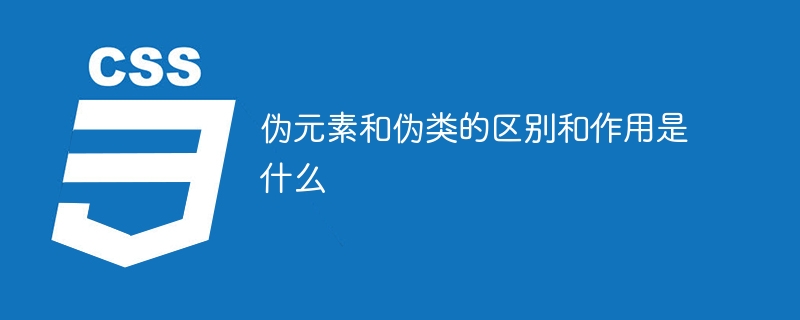 Web Front-end
Web Front-end
 CSS Tutorial
CSS Tutorial
 What are the functions and differences between pseudo-elements and pseudo-classes?
What are the functions and differences between pseudo-elements and pseudo-classes?
What are the functions and differences between pseudo-elements and pseudo-classes?

Pseudo elements and pseudo classes are two important concepts in CSS, and they play a very key role in web design. This article will introduce in detail the differences and functions of pseudo-elements and pseudo-classes, and provide specific code examples.
1. Pseudo elements
Pseudo elements are a way to virtually create elements in a document. Pseudo elements are represented by double colons (::). Common pseudo elements include the following:
- ::before pseudo element:
::before pseudo element is used for selecting elements. Create a dummy element in front. The content of pseudo elements can be set through the content attribute.
Sample code:
<style>
p::before {
content: "前方的虚拟元素";
color: red;
}
</style>
<p>这是正常的段落。</p>With the above code, a red text "dummy element in front" will be inserted before the paragraph element.
- ::after pseudo-element: The
::after pseudo-element is used to create a virtual element behind the selected element. You can also use the content attribute to set the content of the pseudo-element.
Sample code:
<style>
p::after {
content: "后方的虚拟元素";
color: blue;
}
</style>
<p>这是正常的段落。</p>With the above code, a blue text "rear virtual element" will be inserted after the paragraph element.
2. Pseudo-class
Pseudo-class is used to select the changed state of a specific element, or to select an element at a specific position. Pseudo-classes are represented by a single colon (:). Common pseudo-classes include the following:
- :hover pseudo-class:
:hover pseudo-class is used to select the element when the mouse is hovering. status at the time.
Sample code:
<style>
a:hover {
color: red;
}
</style>
<a href="#">鼠标悬停时变为红色</a>The above code will set the font color to red when the mouse is hovering over the link.
- :active pseudo-class:
:active pseudo-class is used to select the state in which the element is activated, usually the state when the mouse is pressed on the element but has not been released.
Sample code:
<style>
button:active {
background-color: blue;
}
</style>
<button>按钮</button>The above code will set the background color to blue when the button is pressed but not released.
- :nth-child pseudo-class:
:nth-child pseudo-class is used to select the specified child element of an element.
Sample code:
<style>
li:nth-child(2) {
color: red;
}
</style>
<ul>
<li>第一个元素</li>
<li>第二个元素</li>
<li>第三个元素</li>
</ul>The above code will select the second li element in the list and set its text color to red.
Summary:
Pseudo elements and pseudo classes play an important role in CSS. Pseudo-elements are used to create virtual elements before and after the selected element, while pseudo-classes are used to select the state or position of a specific element. Through the flexible use of pseudo-elements and pseudo-classes, we can control the style of web pages more abundantly and finely.
The above is the detailed content of What are the functions and differences between pseudo-elements and pseudo-classes?. For more information, please follow other related articles on the PHP Chinese website!

Hot AI Tools

Undresser.AI Undress
AI-powered app for creating realistic nude photos

AI Clothes Remover
Online AI tool for removing clothes from photos.

Undress AI Tool
Undress images for free

Clothoff.io
AI clothes remover

AI Hentai Generator
Generate AI Hentai for free.

Hot Article

Hot Tools

Notepad++7.3.1
Easy-to-use and free code editor

SublimeText3 Chinese version
Chinese version, very easy to use

Zend Studio 13.0.1
Powerful PHP integrated development environment

Dreamweaver CS6
Visual web development tools

SublimeText3 Mac version
God-level code editing software (SublimeText3)

Hot Topics
 1378
1378
 52
52
 Working With GraphQL Caching
Mar 19, 2025 am 09:36 AM
Working With GraphQL Caching
Mar 19, 2025 am 09:36 AM
If you’ve recently started working with GraphQL, or reviewed its pros and cons, you’ve no doubt heard things like “GraphQL doesn’t support caching” or
 Show, Don't Tell
Mar 16, 2025 am 11:49 AM
Show, Don't Tell
Mar 16, 2025 am 11:49 AM
How much time do you spend designing the content presentation for your websites? When you write a new blog post or create a new page, are you thinking about
 Building an Ethereum app using Redwood.js and Fauna
Mar 28, 2025 am 09:18 AM
Building an Ethereum app using Redwood.js and Fauna
Mar 28, 2025 am 09:18 AM
With the recent climb of Bitcoin’s price over 20k $USD, and to it recently breaking 30k, I thought it’s worth taking a deep dive back into creating Ethereum
 Creating Your Own Bragdoc With Eleventy
Mar 18, 2025 am 11:23 AM
Creating Your Own Bragdoc With Eleventy
Mar 18, 2025 am 11:23 AM
No matter what stage you’re at as a developer, the tasks we complete—whether big or small—make a huge impact in our personal and professional growth.
 Vue 3
Apr 02, 2025 pm 06:32 PM
Vue 3
Apr 02, 2025 pm 06:32 PM
It's out! Congrats to the Vue team for getting it done, I know it was a massive effort and a long time coming. All new docs, as well.
 A bit on ci/cd
Apr 02, 2025 pm 06:21 PM
A bit on ci/cd
Apr 02, 2025 pm 06:21 PM
I'd say "website" fits better than "mobile app" but I like this framing from Max Lynch:
 Can you get valid CSS property values from the browser?
Apr 02, 2025 pm 06:17 PM
Can you get valid CSS property values from the browser?
Apr 02, 2025 pm 06:17 PM
I had someone write in with this very legit question. Lea just blogged about how you can get valid CSS properties themselves from the browser. That's like this.
 Let's use (X, X, X, X) for talking about specificity
Mar 24, 2025 am 10:37 AM
Let's use (X, X, X, X) for talking about specificity
Mar 24, 2025 am 10:37 AM
I was just chatting with Eric Meyer the other day and I remembered an Eric Meyer story from my formative years. I wrote a blog post about CSS specificity, and



